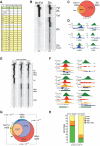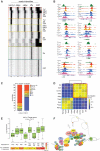Yin Yang 1 extends the Myc-related transcription factors network in embryonic stem cells
- PMID: 22210892
- PMCID: PMC3333890
- DOI: 10.1093/nar/gkr1290
Yin Yang 1 extends the Myc-related transcription factors network in embryonic stem cells
Abstract
The Yin Yang 1 (YY1) transcription factor is a master regulator of development, essential for early embryogenesis and adult tissues formation. YY1 is the mammalian orthologue of Pleiohomeotic, one of the transcription factors that binds Polycomb DNA response elements in Drosophila melanogaster and mediates Polycomb group proteins (PcG) recruitment to DNA. Despite several publications pointing at YY1 having a similar role in mammalians, others showed features of YY1 that are not compatible with PcG functions. Here, we show that, in mouse Embryonic Stem (ES) cells, YY1 has genome-wide PcG-independent activities while it is still stably associated with the INO80 chromatin-remodeling complex, as well as with novel RNA helicase activities. YY1 binds chromatin in close proximity of the transcription start site of highly expressed genes. Loss of YY1 functions preferentially led to a down-regulation of target genes expression, as well as to an up-regulation of several small non-coding RNAs, suggesting a role for YY1 in regulating small RNA biogenesis. Finally, we found that YY1 is a novel player of Myc-related transcription factors and that its coordinated binding at promoters potentiates gene expression, proposing YY1 as an active component of the Myc transcription network that links ES to cancer cells.
Figures






Similar articles
-
In Vivo Chromatin Targets of the Transcription Factor Yin Yang 2 in Trophoblast Stem Cells.PLoS One. 2016 May 18;11(5):e0154268. doi: 10.1371/journal.pone.0154268. eCollection 2016. PLoS One. 2016. PMID: 27191592 Free PMC article.
-
PcG recruitment by the YY1 REPO domain can be mediated by Yaf2.J Cell Biochem. 2010 Feb 15;109(3):478-86. doi: 10.1002/jcb.22424. J Cell Biochem. 2010. PMID: 19960508 Free PMC article.
-
YY1 Positively Regulates Transcription by Targeting Promoters and Super-Enhancers through the BAF Complex in Embryonic Stem Cells.Stem Cell Reports. 2018 Apr 10;10(4):1324-1339. doi: 10.1016/j.stemcr.2018.02.004. Epub 2018 Mar 1. Stem Cell Reports. 2018. PMID: 29503092 Free PMC article.
-
The Yin and Yang of YY1 in tumor growth and suppression.Int J Cancer. 2018 Aug 1;143(3):460-465. doi: 10.1002/ijc.31255. Epub 2018 Jan 31. Int J Cancer. 2018. PMID: 29322514 Review.
-
Yin Yang 1 is associated with cancer stem cell transcription factors (SOX2, OCT4, BMI1) and clinical implication.J Exp Clin Cancer Res. 2016 May 25;35:84. doi: 10.1186/s13046-016-0359-2. J Exp Clin Cancer Res. 2016. PMID: 27225481 Free PMC article. Review.
Cited by
-
Variable requirements for DNA-binding proteins at polycomb-dependent repressive regions in human HOX clusters.Mol Cell Biol. 2013 Aug;33(16):3274-85. doi: 10.1128/MCB.00275-13. Epub 2013 Jun 17. Mol Cell Biol. 2013. PMID: 23775117 Free PMC article.
-
Control of embryonic stem cell self-renewal and differentiation via coordinated alternative splicing and translation of YY2.Proc Natl Acad Sci U S A. 2016 Nov 1;113(44):12360-12367. doi: 10.1073/pnas.1615540113. Epub 2016 Oct 24. Proc Natl Acad Sci U S A. 2016. PMID: 27791185 Free PMC article.
-
Neurodevelopmental disorders, immunity, and cancer are connected.iScience. 2022 May 30;25(6):104492. doi: 10.1016/j.isci.2022.104492. eCollection 2022 Jun 17. iScience. 2022. PMID: 35712080 Free PMC article. Review.
-
Yin Yang 1 Promotes Thymocyte Survival by Downregulating p53.J Immunol. 2016 Mar 15;196(6):2572-82. doi: 10.4049/jimmunol.1501916. Epub 2016 Feb 3. J Immunol. 2016. PMID: 26843327 Free PMC article.
-
Bacon: a comprehensive computational benchmarking framework for evaluating targeted chromatin conformation capture-specific methodologies.Genome Biol. 2022 Jan 21;23(1):30. doi: 10.1186/s13059-021-02597-4. Genome Biol. 2022. PMID: 35063001 Free PMC article.
References
-
- Shi Y, Seto E, Chang LS, Shenk T. Transcriptional repression by YY1, a human GLI-Kruppel-related protein, and relief of repression by adenovirus E1A protein. Cell. 1991;67:377–388. - PubMed
-
- Brown JL, Mucci D, Whiteley M, Dirksen ML, Kassis JA. The Drosophila Polycomb group gene pleiohomeotic encodes a DNA binding protein with homology to the transcription factor YY1. Mol. Cell. 1998;1:1057–1064. - PubMed
-
- Bracken AP, Helin K. Polycomb group proteins: navigators of lineage pathways led astray in cancer. Nat. Rev. Cancer. 2009;9:773–784. - PubMed
Publication types
MeSH terms
Substances
LinkOut - more resources
Full Text Sources
Molecular Biology Databases

